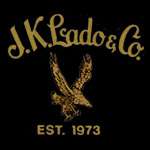Lado Guitars

Lado Musical Inc. is the official company name of what is otherwise known as Lado Guitars or J.K. Lado & Co. (as seen on early-model headstocks), owned and operated by Joe Kovacic - more commonly known as Joe Lado - in Ontario, Canada.
Joe Kovacic and the Lado story
Joseph Kovacic was born in Croatia in 1945. After serving in the Yugoslav People's Army, he began training as a luthier at the Zagreb School of Guitar Making in Zagreb, Croatia, followed by two years additional training at Crossman Guitar Works in Vienna, Austria.
Joe immigrated to Canada from Croatia in 1968 and began working for Turner Musical Instruments, a division of Gibson Guitars for two years, followed by a job with Hagström Guitars as an inspector for one year.
In 1971, having reached a workable level of English, Joe began his own business called Joe's Strings from a basement shop on Gerrard Street, in Toronto, ON
In 1973, he formed Lado Musical Inc. and opened a retail shop on Kingston Road, in Toronto. In addition to building Lado Guitars, Lado had an exclusive repair contract with C.F. Martin Guitars for all of Canada.
Around 1976, the demand for Lado Guitars had grown so much that he moved to a bigger facility in Scarborough, ON.
The 1981 Lado catalogue shows Lado Guitars to have moved again to a new facility - this time located on R.R. #1 in Uxbridge, ON, with a photographed staff of 13 employees.
In 1987, Lado built a 14’ 3” tall, 309 lb “Earth” model guitar, deemed “largest built and presumably the loudest playable electric guitar” by the Guinness Book of World Records. The record was held from 1987-1991.
The 1988 Lado catalogue shows Lado Guitars to have moved from the Uxbridge factory to a new one on Warden Avenue, in Scarborough, ON.
In 2003, Joe started the Lado School of Lutherie. This was a way to slow down his pace as he was reaching retirement, and also to pass on his unique craftsmanship and trade secrets to a younger generation of luthiers.
Today, Lado Musical Inc. is located in Lindsay, ON.
The story behind the "Lado" name
As his major final assignment as a lutherie student, he built a double bass which, upon completion, he gave to a famous Croatian professional folk dance group called "LADO", named after a Slavic word often used as a refrain in ceremonial songs of Croatia, and is a synonym for words meaning "good", "love", and "dear".
In return for their beautiful handcrafted double bass, the Lado group told Joe that he had their blessing to use the Lado name for his instruments.
Traits of a Lado instrument
Most Lado instruments share some unique characteristics that have defined the company with their unique craftsmanship and styling.
- The Lado headstock has always shown the image of a falcon along with the name of the company. It is not to be confused with an eagle or a hawk.
- Necks are always made of multiple laminates of hardwood, rather than one solid block. Three-piece necks are most common.
- Most of the classic Lado instruments are "neck-through-body" designs.
- The back of the headstock bears a serial number with the model name, or a short-code for the model (such as "SF-1" for a Superfalcon guitar), as well as "CDN" or "CND" to designate the instrument as being Canadian-made.
Lado instrument models
Electric guitars
1981 Catalogue
- Standard I guitar model;
- Solo I guitar model;
- Solo III guitar model;
- Solo Doubleneck (6+12);
- Condor guitar model - affectionately known by Joe as "The Cock";
- Falcon (F-1) guitar model;
- Superfalcon (SF-1) guitar model;
- Zebra (Z-1) guitar model;
- Zebra Doubleneck (6+12);
- Flying V (FV 200 Series)
1988 Catalogue (new models)
- Kelly Fleck 335 Style Model*
- Supra I guitar model; Superstrat shape. 1 humbucker.
- Supra III guitar model - Superstrat shape. 3 single coils.
- Classic series - Superstrat guitars of numerous variations. The "Rocker", and "Golden Wing" are part of this series;
2003 Catalogue (new models)
- Earth model - a radical take on the classic Gibson Explorer shape, popularized by Iron Maiden's Adrian Smith;
- Elite model - reminiscent of the Paul Reed Smith shape;
- JK Custom G-32 model - a Gibson Les Paul-styled shape with a semi-hollow body.;
- Vintage TL series - reminiscent of the Fender Telecaster shape;
- Vintage ST series - reminiscent of the Fender Stratocaster shape;
Other Models
- Hawk guitar model;
- Seagull model - possibly a one-off custom - copy of the B.C. Rich Seagull;
- Devil model;
- R-1 guitar model; more info is needed to find out what "R" is short-code for.
- Lazer: Similar in shape to an Earth save for a slight alteration at the bottom of the guitar, forgoing the smooth contour of the Earth. Very limited manufacturing run. It was famously used by Adrian Smith during the Seventh Son of a Seventh Son Tour for the song "Can I Play With Madness".[1]
- Rhoads: A one off, custom copy of a Jackson Randy Rhoads signature model. It featured Lado designed pickups as well as a Floyd Rose Tremolo.
Electric bass guitars
1981 Catalogue
- Standard II bass model - bass version of the Standard I guitar
- Signature model;
- Legend model;
Other Models
- Matrix
- Moonstone model
References
- ↑ Iron Maiden (2013-03-21), Can I Play With Madness (Live Maiden England '88), retrieved 2016-02-11